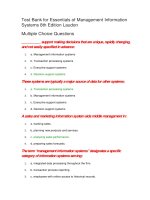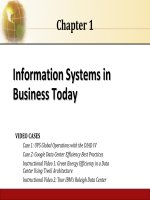Management information systems 13th laudon chapter 07
Bạn đang xem bản rút gọn của tài liệu. Xem và tải ngay bản đầy đủ của tài liệu tại đây (998.69 KB, 46 trang )
Chapter 7
Telecommunications, the Internet, and
Wireless Technology
Video cases:
Case 1: Telepresence Moves Out of the Boardrooom and Into the Field
Case 2: Unified Communications Systems: Virtual Collaboration with Lotus
Sametime
6.1
Copyright © 2014 Pearson Education, Inc. publishing as Prentice
Management Information Systems
Chapter 7: Telecommunications, the Internet, and Wireless Technology
LEARNING OBJECTIVES
• Identify the principal components of telecommunications
networks and key networking technologies.
• Identify the different types of networks.
• Describe how the Internet and Internet technology work and
how they support communication and e-business.
• Describe the principal technologies and standards for
wireless networking, communication, and Internet access.
• Describe radio frequency identification and wireless sensor
networks and identify why these are valuable business
technologies.
7.2
Copyright © 2014 Pearson Education, Inc.
Management Information Systems
Chapter 7: Telecommunications, the Internet, and Wireless Technology
RFID and Wireless Technology Speed Up Production at Continental Tires
• Problem: Inefficient manual processes; large
production environment
• Solutions: Track components in real time, optimize
transportation, and expedite communication
–
–
–
–
Wi-Fi networks
RFID technologies
Mobile handhelds
Material inventory tracking software
• Demonstrates use of technology in production and
supply chain to increase efficiency and lower costs
7.3
Copyright © 2014 Pearson Education, Inc.
Management Information Systems
Chapter 7: Telecommunications, the Internet, and Wireless Technology
Telecommunications and Networking in Today’s Business World
• Networking and Communication Trends
– Convergence:
• Telephone networks and computer networks
converging into single digital network using Internet
standards
– Broadband:
• More than 68% U.S. Internet users have broadband
access
– Broadband wireless:
• Voice, data communication are increasingly taking
place over broadband wireless platforms
7.4
Copyright © 2014 Pearson Education, Inc.
Management Information Systems
Chapter 7: Telecommunications, the Internet, and Wireless Technology
Telecommunications and Networking in Today’s Business World
• Computer network
– Two or more connected computers
– Major components in simple network
•
•
•
•
•
Client and server computers
Network interfaces (NICs)
Connection medium
Network operating system
Hubs, switches, routers
– Software-defined networking (SDN)
• Functions of switches and routers managed by central program
7.5
Copyright © 2014 Pearson Education, Inc.
Management Information Systems
Chapter 7: Telecommunications, the Internet, and Wireless Technology
Components of a Simple Computer Network
Figure 7-1
7.6
Illustrated here is a very simple computer network, consisting of computers, a network operating system
residing on a dedicated server computer, cabling (wiring) connecting the devices, network interface cards
(NIC), switches, and a router.
Copyright © 2014 Pearson Education, Inc.
Management Information Systems
Chapter 7: Telecommunications, the Internet, and Wireless Technology
Telecommunications and Networking in Today’s Business World
• Networks in large companies
– Hundreds of local area networks (LANs) linked to
firmwide corporate network
– Various powerful servers
• Web site
• Corporate intranet, extranet
• Backend systems
–
–
–
–
7.7
Mobile wireless LANs (Wi-Fi networks)
Videoconferencing system
Telephone network
Wireless cell phones
Copyright © 2014 Pearson Education, Inc.
Management Information Systems
Chapter 7: Telecommunications, the Internet, and Wireless Technology
Corporate Network Infrastructure
Today’s corporate network
infrastructure is a collection of
many different networks from
the public switched telephone
network, to the Internet, to
corporate local area networks
linking workgroups,
departments, or office floors.
Figure 7-2
7.8
Copyright © 2014 Pearson Education, Inc.
Management Information Systems
Chapter 7: Telecommunications, the Internet, and Wireless Technology
Telecommunications and Networking in Today’s Business World
• Key digital networking technologies
– Client/server computing
• Distributed computing model
• Clients linked through network controlled by network
server computer
• Server sets rules of communication for network and
provides every client with an address so others can find
it on the network
• Has largely replaced centralized mainframe computing
• The Internet: largest implementation of client/server
computing
7.9
Copyright © 2014 Pearson Education, Inc.
Management Information Systems
Chapter 7: Telecommunications, the Internet, and Wireless Technology
Telecommunications and Networking in Today’s Business World
• Key digital networking technologies (cont.)
– Packet switching
• Method of slicing digital messages into parcels
(packets), sending packets along different
communication paths as they become available, and
then reassembling packets at destination
• Previous circuit-switched networks required assembly
of complete point-to-point circuit
• Packet switching more efficient use of network’s
communications capacity
7.10
Copyright © 2014 Pearson Education, Inc.
Management Information Systems
Chapter 7: Telecommunications, the Internet, and Wireless Technology
Packet-Switched Networks and Packet Communications
Figure 7-3
7.11
Data are grouped into small packets, which are transmitted independently over various communications
channels and reassembled at their final destination.
Copyright © 2014 Pearson Education, Inc.
Management Information Systems
Chapter 7: Telecommunications, the Internet, and Wireless Technology
Telecommunications and Networking in Today’s Business World
• Key digital networking technologies (cont.)
– TCP/IP and connectivity
• Protocols: rules that govern transmission of information
between two points
• Transmission Control Protocol/Internet Protocol (TCP/IP)
– Common worldwide standard that is basis for Internet
• Department of Defense reference model for TCP/IP
– Four layers
»
»
»
»
7.12
Application layer
Transport layer
Internet layer
Network interface layer
Copyright © 2014 Pearson Education, Inc.
Management Information Systems
Chapter 7: Telecommunications, the Internet, and Wireless Technology
The Transmission Control Protocol/Internet Protocol (TCP/IP) Reference Model
This figure illustrates the four
layers of the TCP/IP reference
model for communications.
Figure 7-4
7.13
Copyright © 2014 Pearson Education, Inc.
Management Information Systems
Chapter 7: Telecommunications, the Internet, and Wireless Technology
Communications Networks
• Signals: Digital versus analog
– Modem: translates digital signals into analog form
(and vica versa)
• Types of networks
– Local-area networks (LANs)
• Ethernet
• Client/server vs. peer-to-peer
– Wide-area networks (WANs)
– Metropolitan-area networks (MANs)
– Campus area networks (CANs)
7.14
Copyright © 2014 Pearson Education, Inc.
Management Information Systems
Chapter 7: Telecommunications, the Internet, and Wireless Technology
Functions of the Modem
Figure 7-5
7.15
A modem is a device that translates digital signals into analog form (and vice versa) so that computers can
transmit data over analog networks such as telephone and cable networks.
Copyright © 2014 Pearson Education, Inc.
Management Information Systems
Chapter 7: Telecommunications, the Internet, and Wireless Technology
Communications Networks
• Physical transmission media
–
–
–
–
Twisted pair wire (CAT5)
Coaxial cable
Fiber optics cable
Wireless transmission media and devices
• Satellites
• Cellular systems
• Transmission speed
– Bits per second (bps)
– Hertz
– Bandwidth
7.16
Copyright © 2014 Pearson Education, Inc.
Management Information Systems
Chapter 7: Telecommunications, the Internet, and Wireless Technology
The Global Internet
• The Internet
– World’s most extensive network
– Internet service providers (ISPs)
• Provide connections
• Types of Internet connections
– Dial-up: 56.6 Kbps
– Digital subscriber line (DSL/FIOS): 385 Kbps–40
Mbps
– Cable Internet connections: 1–50 Mbps
– Satellite
– T1/T3 lines: 1.54–45 Mbps
7.17
Copyright © 2014 Pearson Education, Inc.
Management Information Systems
Chapter 7: Telecommunications, the Internet, and Wireless Technology
The Global Internet
• Internet addressing and architecture
– IP addresses
• The Domain name system (DNS)
– Converts IP addresses to domain names
– Hierarchical structure
– Top-level domains
• Internet architecture and governance
– No formal management: IAB, ICANN, W3C
– The future Internet: IPv6 and Internet2
7.18
Copyright © 2014 Pearson Education, Inc.
Management Information Systems
Chapter 7: Telecommunications, the Internet, and Wireless Technology
The Domain Name System
The Domain Name System is a
hierarchical system with a root
domain, top-level domains,
second-level domains, and host
computers at the third level.
Figure 7-6
7.19
Copyright © 2014 Pearson Education, Inc.
Management Information Systems
Chapter 7: Telecommunications, the Internet, and Wireless Technology
Internet Network Architecture
The Internet backbone connects
to regional networks, which in
turn provide access to Internet
service providers, large firms,
and government institutions.
Network access points (NAPs)
and metropolitan area
exchanges (MAEs) are hubs
where the backbone intersects
regional and local networks and
where backbone owners
connect with one another.
Figure 7-7
7.20
Copyright © 2014 Pearson Education, Inc.
Management Information Systems
Chapter 7: Telecommunications, the Internet, and Wireless Technology
Interactive Session: Organizations
The Battle over Net Neutrality
Read the Interactive Session and discuss the following questions
– What is network neutrality? Why has the Internet
operated under net neutrality up to this point in time?
– Who’s in favor of network neutrality? Who’s opposed?
Why?
– What would be the impacts on individual users,
businesses, and government if Internet providers switched
to a tiered service model?
– Are you in favor of legislation enforcing network
neutrality? Why or why not?
7.21
Copyright © 2014 Pearson Education, Inc.
Management Information Systems
Chapter 7: Telecommunications, the Internet, and Wireless Technology
The Global Internet
• Internet services
– Chatting and instant messaging
– Electronic discussion groups / newsgroups
– Telnet
– File Transfer Protocol (FTP)
– World Wide Web
7.22
Copyright © 2014 Pearson Education, Inc.
Management Information Systems
Chapter 7: Telecommunications, the Internet, and Wireless Technology
Client/Server Computing on the Internet
Figure 7-8
7.23
Client computers running Web browser and other software can access an array of services on servers over the
Internet. These services may all run on a single server or on multiple specialized servers.
Copyright © 2014 Pearson Education, Inc.
Management Information Systems
Chapter 7: Telecommunications, the Internet, and Wireless Technology
The Global Internet
– Voice over IP (VoIP)
• Digital voice communication using IP, packet switching
• Providers
– Cable providers
– Google, Skype
– Unified communications
• Communications systems that integrate voice, data,
e-mail, conferencing
– Virtual private network (VPN)
• Secure, encrypted, private network run over Internet
– PPTP
– Tunneling
7.24
Copyright © 2014 Pearson Education, Inc.
Management Information Systems
Chapter 7: Telecommunications, the Internet, and Wireless Technology
How Voice over IP Works
Figure 7-9
7.25
A VoIP phone call digitizes and breaks up a voice message into data packets that may travel along different
routes before being reassembled at the final destination. A processor nearest the call’s destination, called a
gateway, arranges the packets in the proper order and directs them to the telephone number of the receiver or
the IP address of the receiving computer.
Copyright © 2014 Pearson Education, Inc.









